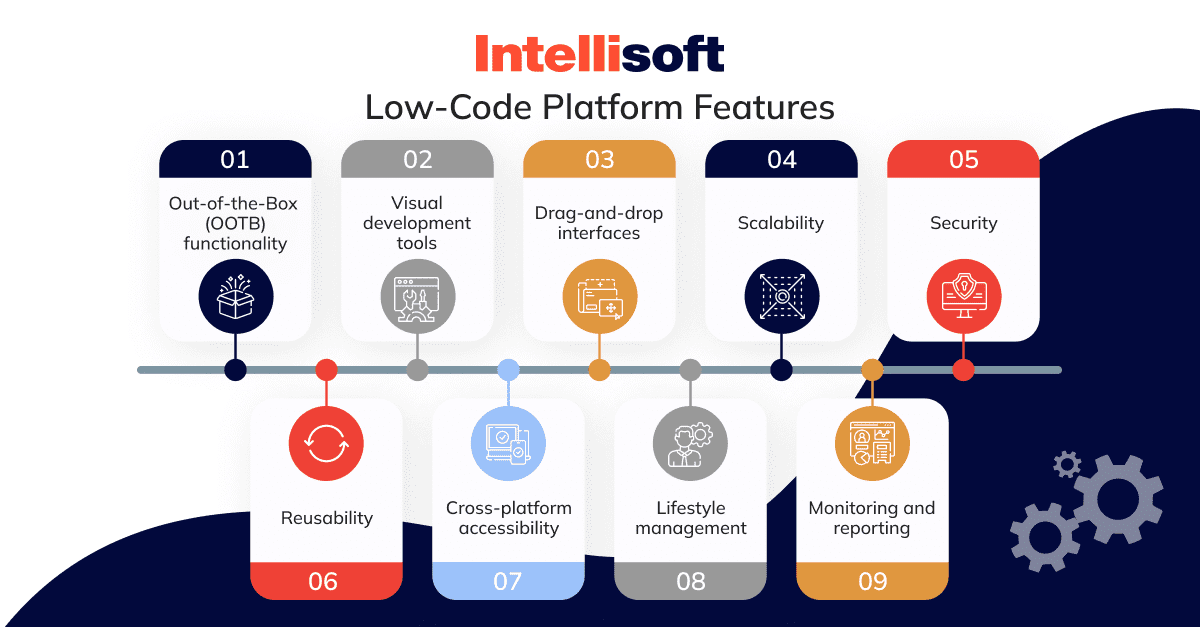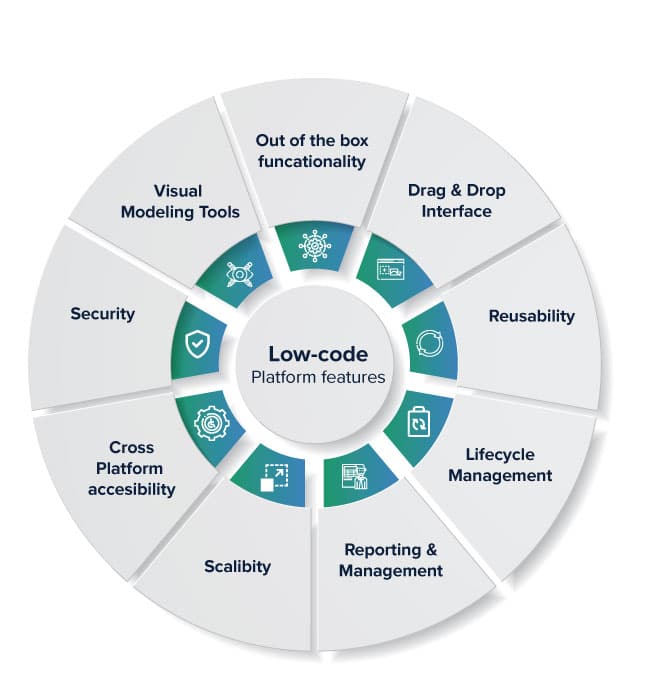Visual Development Environment :
Drag-and-Drop Interfaces: Low-code platforms provide visual tools for designing applications. Drag-and-drop elements allow developers to quickly build applications, without needing to write code.
Templates and components that are pre-built A lot of low-code platforms have pre-built components and templates, which allow developers to quickly prototype and develop applications.
Reduced Coding Requirements:
Automated Code Generating: The low-code platform generates the code beneath based on the visual models that developers design. This eliminates the need to write code manually and speed up the process of developing.
Reusable components: Developers can to reuse components across multiple projects, which can reduce the amount of time they're spending creating and evaluating code.
Collaboration is made easier:
Integrated Development Tools: Low code platforms usually include tools for testing versions, deployment and version control. They facilitate collaboration among teams.
Citizen Development (Citizen Development) Developers and users of business applications can participate in the development of applications using intuitive interfaces. This can help reduce the burden caused by a lack of accessibility of professional developers.
Rapid prototyping and rapid iteration
Rapid Prototyping. Developers can design prototypes quickly in order to test their ideas and get feedback. This can lead to a faster iteration cycle.
Easy Modifications – The visual nature of low-code applications allows easy updates and changes which speed up the refining of applications based upon user feedback.
Pre-built Integrations:
API Integrations: Platforms that are low-code typically come with pre-built connectors for well-known APIs and services which reduce the time needed to connect external systems.
Data Integration: The instruments built within the software ease and accelerate the process of connecting databases, data sources and applications.
Deployment Scaling
One-Click Installation: A lot of low-code platforms provide the option of installing with one click that reduces the amount of effort and time required to install software.
Cloud-based solution: Cloud based low code platforms are capable of handling infrastructure management and scaling. This allows developers to focus more on functionalities, application logic and features instead of deployment logistics.
Overall, low-code development has the advantage in terms speed due to its ability of automating and simplifying many elements of development. This allows faster delivery of apps and easier adapting to the changing demands. Check out the best funny post for Low-code Platform for application development for site examples including lowcode no code, microsoft azure sql, develop cross platform mobile app, azure sql, stored sql procedures, driver jdbc, lowcode no code, app modernization, cross platform app development, cloud software applications and more.

Low-Code Application Development Offers Numerous Benefits, Particularly In The Area Of Cost-Effectiveness.
Low-code application development has numerous advantages, including cost-effectiveness. It is a popular choice for companies who wish to reduce development costs without sacrificing quality. These are the major benefits: Reduced costs for development:
Fewer Coding Requirements: Low code platforms eliminate the need for lengthy, hand-coded applications. Developers will spend less time and effort creating applications. This leads to lower costs of labor.
We require fewer developer resources: Low-code development takes less time and is simpler. This means that fewer developers are required. This reduces the need for costs of recruiting and retaining personnel.
Faster time to market
Accelerated cycle of development: Visual tools for development as well as pre-built components provided by platforms with low-code support rapid application design, allowing firms to bring their products to market quicker. This could result in faster revenue generation and improved competitive positioning.
Rapid prototyping. Businesses can quickly test and build prototypes. This helps reduce time in the development process and allows for faster iterations that are built on feedback from users.
Lower cost of maintenance:
Simpler maintenance: Low-code platforms, with their standardised components and modular architecture make them easier to maintain. This reduces maintenance and support costs.
Automated Updates - A lot of low-code systems are capable of managing updates and patches in a manner that is both secure and timely. This eliminates the need for manual intervention.
Efficient Resource Utilization:
Low-code platforms allow businesses and other non-developers to be part of the process of development. This makes it possible for businesses to take advantage of the talents of a diverse range of employees.
IT Departments can Focus on Strategic Initiatives instead, of being bogged down by routine development tasks IT departments are able to focus their energies on strategic initiatives that improve productivity and efficiency.
Price models that can be scaled:
Subscription-Based Pricing: A lot of low-code platforms offer flexible, subscription-based pricing models that scale with usage. This allows businesses to be able to align their spending with the actual demands and growth while avoiding large initial costs.
Pay-as-you go options Certain platforms offer pay-as-you-go options that ensure that businesses pay only for the resources they utilize that are useful for small and new companies with limited funds.
Lower costs for third-party software:
Built-in Functionalities : A low-code software often comes with built-in functionality and integrations which reduces the requirement for additional third-party software, tools, and licenses.
Pre-Built Integrations: The existence of pre-built integrations for popular systems and services reduces the requirement for custom development, thereby saving time and money.
Higher ROI
A faster return on investment: The combination of speedy development, less expensive and a faster time to market mean that companies will see a higher ROI (ROI) on their software.
Increased Agility: Businesses are able to quickly adapt to changes in the market and customer needs to ensure they remain relevant and can capitalize on new opportunities that arise.
Reduced Training Costs
User-friendly interfaces: Low-code systems provide user-friendly and easy interfaces that help reduce the time required to learn. They also minimize the need for lengthy training programs.
Accessible Resources - A lot of low code platforms come with complete tutorials and training materials as well as community assistance. These tools reduce the need for formal instruction and its associated expenses.
Collaboration can be streamlined.
Enhanced Collaboration Tools : The collaboration tools integrated into the software aid in collaboration and communication between the team members. This leads to more efficient project development process and lower overhead.
Unified Development Environment : A unified environment makes work easier and cuts down on the expenses of managing multiple tools and platforms.
In general, applications that use low-code are cost-effective because of their ability to cut costs for maintenance and development, to accelerate time-to-market, to maximize resource use, and to provide flexible pricing. The combination of these factors can provide firms significant financial benefits and makes low-code an appealing option for companies seeking to maximize development budgets, while still creating strong and adaptable applications. Have a look at the most popular Legacy application modernization with Low-code advice for blog recommendations including stored sql procedures, lowcode no code, rapid applications, develop web app, sso azure, multiplatform mobile app development, push notifications, low code development platforms, rad development, app modernization and more.

Advantages Of Low Code Application Development In Terms Of The Limitations And Customization
Low-code design for applications is a balanced, flexible approach that overcomes issues and permits customisation. Here are some benefits:
Resolving Complexity:
Simple development: Low-code platforms make it easier to develop by offering templates and pre-built components. This helps speed up application deployment, even for more complex ones.
Many platforms have guided workflows, which assist developers navigate through complicated processes. They reduce the chance of errors and ensure the consistency.
Scalability Solutions
Scalability is a part of the Low-code platform often includes capabilities that permit the development of scalable architecture. Applications can handle increasing demands with little changes.
Performance Monitoring: Integrated instruments for monitoring performance and optimization help ensure that applications are efficient as they scale.
Security and Compliance
Integrated Security Features : Low code platforms are equipped with security measures built in like encryption and access control based on role. They also conduct automated compliance checks to deal with security concerns.
Platforms update frequently their security protocols, and ensure compliance with regulatory requirements. This helps to keep applications safe from emerging threats.
Customization capabilities:
Extensibility:
Low-code platforms let developers extend functionality beyond standard offerings by using customized code.
Developers are able to add extensions or modules to address specific business requirements.
APIs and integration:
API Support: A comprehensive support for APIs facilitates seamless integration with other systems and services. This allows for customizing and connectivity.
Low-Code Platforms: These platforms come with built-in connectors for popular third-party service providers, making it easier to add and modify apps.
Flexible UI/UX design:
Customizable interfaces: Users can customize and design their own user interfaces that will give a more tailored experience.
Responsive Design Built-in features of responsive design ensure that applications are able to be tailored to various screen sizes and devices.
The process of customizing Business Logic is easy:
Visual Workflow Builds Visual tools that permit customization of workflows as well as business rules and to design complex, tailored processes.
Conditional Logic and Scripting: Platforms enable the integration of conditional logic as well as customized scripting to deal with specific business rules and situations.
Data Management
Custom Data Models: Developers may develop custom data models that fit specific needs of the application to ensure that data processing is customized to the business needs.
Advanced Data processing Integration advanced tools for data handling allow for the customisation of the data analysis process and use in the program.
How do you balance personalisation and limitations:
Frameworks and Standards
Best Practices: Low-code platform encourages compliance with standards and best practices in the industry. This is helpful to ensure high-quality apps that are scalable, secure and reliable.
Governance Frameworks: Integrated governance frameworks make sure that customizations don't compromise the integrity, conformity, or the security of an application.
Iterative Development:
Rapid prototyping: Developers are able to quickly test and prototype customizations based on the feedback of users, and improve the app based on their needs.
Low-code platforms have been designed to support continual enhancement. This allows for customizations and enhancements as business requirements evolve.
User Empowerment
Low-code platforms allow citizen developers to develop by allowing non-developers through intuitive interfaces to customize applications, they expand the number of contributors who can enhance and tailor apps.
Training and Support: Many platforms provide extensive training and support resources to assist users with effective customizations without compromising the application's stability or performance.
In general, low-code application development offers a solid framework to address weaknesses and provides a wide range of possibilities for customization. This allows companies to develop and maintain functional applications tailored to their needs while ensuring high standards of quality, security, and the ability to scale.
